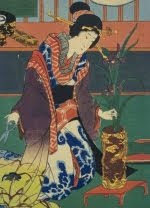Serene colours.
Equisetum, Chrystanthemum and Gerbera.
This arrangement, in a large moribana container, consists of three groups of flowers in the colour range of yellow to orange, and a green structure of bent Equisetum with wire in it. The materials are leftover flowers that have been around for a bit more than a week now.
German born American artist Josef Albers is known for his square paintings and optical experiments. He also worked theoretically with colours and further developed the theories by his teacher Johannes Itten at the Weimar Bauhaus. Amongst other things he worked on expressive colour combinations, based on the colour star of Goethe and the coulor triangle. By grouping the colours of the triangle in colour chords he developed a system based on their expressive qualities. My leftover ikebana is based on the Serene colour chord - green, yellow, orange and yellow-orange.
Equisetum, Chrystanthemum and Gerbera.
This arrangement, in a large moribana container, consists of three groups of flowers in the colour range of yellow to orange, and a green structure of bent Equisetum with wire in it. The materials are leftover flowers that have been around for a bit more than a week now.
German born American artist Josef Albers is known for his square paintings and optical experiments. He also worked theoretically with colours and further developed the theories by his teacher Johannes Itten at the Weimar Bauhaus. Amongst other things he worked on expressive colour combinations, based on the colour star of Goethe and the coulor triangle. By grouping the colours of the triangle in colour chords he developed a system based on their expressive qualities. My leftover ikebana is based on the Serene colour chord - green, yellow, orange and yellow-orange.




.jpg)















